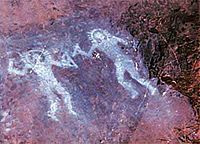Italian history can be said to have started in the 9th century BC,high when earliest accounts record the presence of Italic tribes in present-day central Italy. Linguistically, they were divided into Oscans, Umbrians and Latins. Later the Latin culture became dominant, as Rome emerged as a powerful city-state around 350 BC. Other pre-Roman civilizations include Magna Graecia (or Greater Greece), when Greeks began settling in Southern Italy in the 8th century BC and lasted until the 3rd century BC and also the Etruscan civilization, which flourished between 900 and 150 BC in the central section of the peninsula. The Roman Empire later dominated Western Europe and the Mediterranean for many centuries, making immeasurable contributions to humanity. Some of these led to the development of Western philosophy, science and art, that remained central during the Middle Ages and the Renaissance. After the fall of Rome in AD 476, Italy remained fragmented in numerous city-states for much of the following millennium, finally falling under different foreign dominations. Parts of Italy were annexed to the Spanish, the Austrian and Napoleon I's empire, while the Holy See maintained control over Rome, before the Italian Peninsula was eventually liberated and unified in the late 19th century. The new Kingdom of Italy, established in 1861, quickly modernized and built a large colonial empire, colonizing parts of Africa, and countries along the Mediterranean. However, many regions of the young nation (notably, the South) remained rural and poor, originating the Italian diaspora. Italy wins the World War I against its historical enemies, the Austrian Empire. Soon afterwards, however, the liberal state collapsed to social unrest: the Fascists, led by Benito Mussolini, took over and set up an authoritarian dictatorship. Italy joined the Axis powers in World War II, falling into a bloody Civil War after a monarchist coup ousted Mussolini in 1943, surrendering to the Allies in 1943, so eventually winning the war against Fascists and Nazi Germany in 1945. In 1946, as a result of a Constitutional Referendum, the monarchy was abolished. The new republic was proclaimed on 2 June 1946. In the 1950s and 1960s, Italy saw a period of rapid modernization and sustained economic growth, the so-called Italian economic miracle. The country, coming back to international politics among Western democratic powers, joined the European Economic Community (which has later constituted the European Union), the United Nations, NATO, the G7 and the Organisation for Economic Co-operation and Development. Italy is currently ranked as a major regional power.




Aipatu
0